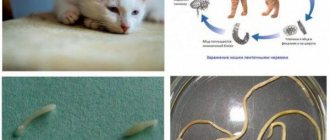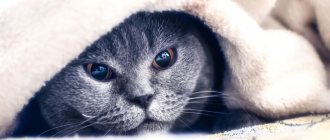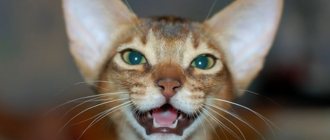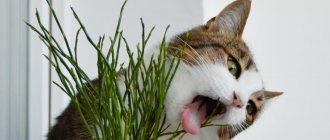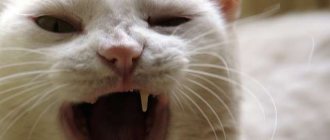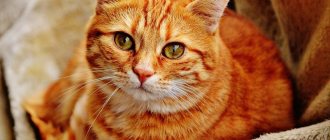Why do cats love to rub against people and objects?
Contents hide
Why do cats love to rub against people and objects?
We address this article mainly to novice cat lovers, because these wonderful animals often demonstrate, to put it mildly, somewhat strange behavior to their owners. But this behavior is by no means a quirk of your cat; it usually means something! To better know and understand your pet, it is advisable to understand and study everything. Some of the strange behavior of cats is often interpreted erroneously: for example, when a cat begins to rub against its owner's legs, it is believed that it is simply caressing. No: the cunning creature pursues completely different goals!
The importance of smell. Our furry friends have a sense of smell 200 times more sensitive than you and I
So you can put into circulation the stable expression “cat’s scent”, and it will be fair! In addition, cats both transmit and sense pheromones. They are spread by special glands located in the area of the paw pads, forehead, cheeks, chin, lips and tail area. Pheromones are unique for each animal, its unique calling card. The cat will walk by, rub various parts of its body against people or some objects, and mark them - that is, leave its unique scent. Other cats quickly recognize (feel) them and realize: this place is already occupied by another cat who was here before me.
Expressing good feelings. Cat lovers know well that their pets, in moments of pleasant mood, love to rub their faces or even lightly butt their owners with them. You understood everything correctly: and at this moment the cat releases pheromones. But “facial” pheromones have a special effect - the animal calms down, demonstrates affection and friendliness. Sometimes a cat rubs its muzzle against things and objects - this is normal. You and I pet cats, play cuddle games, animals rub against us during petting. It is at this moment that there is an intense exchange of odors. Cats thereby show that we humans completely belong to them and are in their power. And try to argue something!
Means of communication. A cat can send unambiguous hints to its owners - it’s time, dear man, to have some food! In this case, the animal will write out complex steps around the legs of its owners, then, as if by chance, walk to its bowls, demonstrating where to go and what operations to perform. Then he returns to his feet - well, let's go quickly, sloth!
Some cats accompany their unlucky owners to the trays, suggesting that they have long been in need of cleaning and cleaning. Sometimes cats literally launch a frontal attack: that is, they move their foreheads towards their owner, lightly butt them, and then expose their necks. What to do? Of course, scratch and stroke your pet in the most sensitive places!
There are several cats in the house
If you have several cats in your house, then pay attention - they butt and rub against each other in the same way. The essence of the process is the same: animals exchange odors
This is how they feel safe and comfortable - they now perceive the unique smells of their “comrades” exclusively as friendly, “group” ones. Look: as soon as one cat leaves its scent somewhere, another will immediately come up to this place and rub its muzzle.
And finally, the last fact: the cat, when searching for a “gentleman” and attracting him for mating, also uses the appropriate pheromones. Sometimes there are so many contenders for the heart of a furry beauty!
Photo: viralife.ru, lol24.ee (from open sources).
How to deal with this cat behavior?
If the episodes of attacks on your legs do not stop, and the scratches become deeper and deeper, then measures must be taken to wean the cat from throwing itself on its legs. So, what can you do in this situation:
- Give your pet as much attention as possible. Be sure to find time every day for active games. You just need to play with the cat when he wants it, and not when he is sleeping peacefully on the windowsill, and you suddenly remembered that you need to play with him. Use a variety of gaming equipment in your games: a ball for the cat to run after; a soft toy that you can “wrestle” with; a game fishing rod will allow you to play the role of a predator;
- Organize a space around that is as interesting as possible for your cat. You can buy interesting toys, or you can make them yourself. Also regularly offer your pet empty cardboard boxes and bags - fluffies absolutely love these items. You can buy your cat a puzzle toy, this can keep her away from your feet for a long time. But periodically you need to hide the toy so that your pet doesn’t get tired of it. In addition, play complexes, scratching posts, etc. provide excellent occupancy for cats;
- Give your cat a time out. If you feel that the initially innocent play with your leg is gaining momentum, and your pet has become so wound up that its aggression is no longer controllable, then take a break. Leave the room, close the door behind you. Just don't do the opposite! You don’t need to pick up the cat and take it to another room, you need to leave the room yourself and let your pet understand the cause-and-effect relationship between his actions and yours;
- Try to prevent the attack. Usually the cat jumps out of the shelter, declassify its place and before the cat jumps out from there, start moving towards it. This will confuse your pet, because for him your legs are a victim, and he himself is a predator. If you start moving towards him, this will break the cat’s concept of the victim - after all, the victim does not go towards the predator, but rather runs away from him;
- Limit access to those places from which the cat rushes at you. They can be forced with something or a minor rearrangement can be made. This will force the furry to look for a new place, and this will distract him from you for a while.
In the process of weaning yourself from attacking your legs, the main thing is not to show your own aggression and anger. Under no circumstances should you punish your pet for such behavior, much less use force. Because aggression begets aggression. This rule applies not only to relationships with people, but also to relationships between people and their smaller brothers. Show restraint and calm, because aggressive behavior can be perceived by a cat as a challenge, and not as a punishment for behavior. Also, reward your pet for good behavior, as cats tend to repeat behavior that has positive consequences for them. For example, if a cat plays with you affectionately, without digging its claws, then reward it immediately, because this will help establish a clear association between kind play and, for example, receiving a treat.
Changing Tray or Litter Preferences
Cats are mysterious creatures. Even if a cat has been using the same litter box and litter for many years, its preferences may change with age. Keep the litter box clean; many cats prefer to use only clean litter or have a second litter box for defecation.
If you keep several cats, then the number of trays should exceed the number of cats by one, that is, two cats need three trays (there may be no problems with unclean behavior even if there is one tray for many cats, but this is an exception to the rule and rather means only that these cats endure discomfort).
Pay attention to the location of the tray. Urination is an intimate process and a tray located near a washing machine, repair work, or front door can scare away a cat
A strong smell can ruin a cat's relationship with the litter box - an air freshener in the toilet, a new scented laundry detergent in the bathroom, or even the litter box itself, if it is scented.
Treatment
The tactics of the prescribed treatment depend on the causes of ataxia. B vitamins, especially B12, are mandatory. Gamavit is used to strengthen the immune system and the body as a whole.
The medicinal substance Proserin also penetrates well through the blood-brain barrier and helps restore nerve conduction.
With cerebellar ataxia, treatment of the disease is extremely difficult. After all, the basis of the disease is degenerative changes in the brain. Cerebrolysin (Cerebrolysate) is used to improve cerebral circulation and tissue regeneration.
To improve the functioning of brain tissue, glycine is used 0.25 t once a day for 2 weeks, piracetam 0.3 ml IV and caviton 0.25 t 3 times a day for a week.
In case of spinal cord damage, surgical treatment is prescribed in most cases. Physiotherapy is also used - UHF, UMI (pulse therapy), massage.
If there is an infection, then antibiotics are used - ampicillin, vancomycin. Often the cat will require anti-toxic therapy. To do this, use a drip infusion of saline solutions - saline solution with glucose. Glucocorticosteroids – prednisolone – are also administered.
If there is cerebral edema or hydrocephalus, diuretics are prescribed - furosemide, veroshpiron.
Severe tremor can be relieved by using diazepam, but in this case it is necessary to carefully monitor the condition of the liver and prescribe minimal doses of the drug, as it is toxic to the liver.
Owners of kittens with cerebellar ataxia should remember that after the animal reaches the age of 1 year, its condition stabilizes, and the pet can continue to live happily. Such pets have extraordinary intelligence and kindness, but they require the safest possible life and good care, and, of course, love and affection.
Now in the United States there is even a special queue where residents sign up to shelter animals with this diagnosis.
What is ataxia?
Without going into details, this is the name for a set of symptoms that imply problems with coordination of movements and body position in space. There are three types of this pathology:
Cerebellar ataxia in cats is caused by damage to the cerebellum.
Accordingly, vestibular occurs in cases where something is very wrong with the vestibular apparatus located in the inner ear.
Sensitive. In some ways it is similar to the cerebellar, only in this case important nerve cords are damaged.
There are different causes of ataxia in cats. Most often, the development of the disease is due to:
Poisoning with various poisons.
Hereditary diseases accompanied by degenerative phenomena in the nervous tissue.
Injuries that occur especially often in March, when loving cats fall from balconies.
Lack of vitamin B1. This is generally typical for cats: many owners “pamper” them with fresh river fish, which contains the enzyme thiaminase. It destroys thiamine, that is, B1, resulting in ataxia. This is especially noticeable in kittens.
If the cat is “hooked” on some plants. For example, a large dose of catnip can send a cat into “nirvana” for several minutes. At this time, the pet looks like an inveterate drunkard.
Traumatic brain injury.
Tumor.
Infection. In particular, feline panleukopenia is very dangerous.
Hydrocephalus or cerebral edema.
Unfortunately, these are not all the reasons. Cerebral hypoplasia is a fairly common hereditary lesion of the cerebellum. This phenomenon develops in almost 70% of cases in kittens whose mother suffered from panleukopenia during pregnancy. In addition, it is possible that this pathology may develop with other infectious diseases that the cat picked up while in an “interesting situation.” Helminths can also help.
In very rare cases, ataxia develops due to lysosomal deficiency. There is such an intracellular organelle called a lysosome. It is needed to dispose of peroxide compounds and other nasty things. If there is something wrong with the lysosomes, all these substances begin to accumulate in the body. This pathology is extremely rare, incurable, and its prognosis is poor.
Pathologies in which a cat falls on its side when walking
This symptom may include epilepsy, stroke, development of paralysis or paresis, muscle dystrophy or ataxia.
A cat with epilepsy falls on its side.
Depending on the nature of the pathology, the onset of symptoms can occur either slowly or rapidly.
.
In both cases, contacting a veterinarian is mandatory
. In addition to the obvious sign, there may be a shaky, uncertain gait, fear of movement, and the animal cannot lean on one of the sides or limbs.
Paralysis or paresis
The development of paralysis or paresis can occur, inflammatory processes, and disturbances in the blood flow of the body.
But it can also be explained by injuries to the back and spine. With this disease, parallel symptoms are observed: fainting, “shifty” eyes - nystagmus, inappropriate behavior, pupils of different sizes.
With paralysis, fainting occurs.
If the lumbar or pelvic area is affected
, there may be a violation of the act of defecation and urination. Similar symptoms will occur with spinal cord oncology or with nutritional hyperparathyroidism.
Muscle weakness
Muscle weakness in a cat is accompanied by lethargy.
Muscle weakness is provoked by myopathy based on potassium deficiency in the body, infectious diseases, viruses, in particular botulism.
Parallel symptoms of internal bleeding may include cold extremities
, lethargy, refusal of food and water, constant drowsiness, bluish mucous membranes.
Ataxia
The presence of ataxia is characterized by periodic rolling over on one side.
Ataxia can be congenital or acquired depending on its occurrence factors.
They differ in appearance into vestibular, cortical, cerebellar, and sensitive forms.
. The presence of ataxia is characterized by an unsteady gait and periodic lying on one side.
- The animal walks very unsteadily, stepping on its paws with caution.
- The head is tilted down or to the side, muscle tremors are possible.
- The following are often involved in the development of pathology: various poisonings, traumatic brain injuries, cerebral edema.
- At the same time, cerebellar ataxia is most common in small kittens and occurs due to hypoplasia of the cerebellar structure.
Epileptic seizure
An epileptic seizure is manifested not only by falling on one side, but also by the onset of convulsions, twitching of the paws, involuntary closing of the jaws or uncontrolled urination.
During an epileptic seizure, convulsions occur in the cat.
Stroke
The stroke is accompanied by a loud cry in the cat.
During a stroke, the animal experiences circular movements and loud meowing due to severe pain. And also fainting.
Otitis
With otitis media, a cat has ear pain.
A possible reason for the appearance of this symptom may be otitis media, leading to a disorder in the functioning of the vestibular apparatus. Additional symptoms are loss of appetite, foul odor from the ear, discharge of purulent exudate, pain in the ear area.
ACS diagnostics
To accurately determine the cause of a change in behavior in a cat, a complete examination is necessary. Unfortunately, both diagnosis and treatment of behavioral problems are often complicated by the presence of various diseases in the animal. And sometimes a combination of pathologies makes behavioral disorders especially severe.
On the other hand, sometimes behavioral symptoms that are actually caused by a serious illness are attributed to cognitive dysfunction syndrome.
The owner’s task is to identify “abnormalities” in the pet’s behavior and promptly report them to the doctor.
In addition to changing behavior, it is important to monitor the amount of food and water consumed, weight loss, frequency of bowel movements and urination, etc.
And, of course, older animals need to regularly (1-2 times a year, more often with significant deviations) visit the veterinary clinic for a comprehensive examination (measurement of body weight, blood pressure, determination of the condition of the retina, concentration of thyroid hormones, physical activity, orthopedic and neurological examination, ultrasound diagnostics, tests and blood tests (general and biochemical), urine, etc.).
Dear owners! Timely detection of the disease and its correct treatment mean extended years of life for your pet.
Where does SKD come from?
Possible reasons:
- disturbance of cerebral blood supply - a change in the circulatory system of the brain due to hypoxia caused by heart disease, hypertension, anemia, impaired blood clotting, the formation of small hemorrhages near blood vessels, arteriosclerosis
- tissue damage from free radicals As cells age, they process nutrients less and less well, the amount of energy decreases, and the number of free radicals in the cells increases, which the body’s antioxidant defense does not have time to neutralize. An excess of these radicals leads to tissue damage, with brain tissue being especially sensitive.
Why do cats rub against their owners' legs?
Almost all cat owners are familiar with the greeting ritual, during which the cat rubs its owner's ankles, first with its head, then with its sides and, finally, with its tail. This is reminiscent of a gesture of affection on the part of a cat. Is it really? Is there another explanation for this behavior?
Almost all cat owners have experienced this behavior. The cat greets its owner with a special greeting ritual when it comes home. First, she rubs her head against her ankles, then her sides, and finally her tail, which she wraps around a person’s leg. After this, the cat raises its head up and, looking at the owner, again begins to rub against him, bouncing slightly on its front legs. For the owners, such a ritual evokes only positive emotions. Most respond by petting the cat,
interpreting such behavior as a gesture of affection on the part of the animal. In reality, we are simply talking about olfactory markings. During this ritual, olfactory communication occurs, as a result of which the smell appropriate to the members of its “territory” is restored. When an animal rubs, it produces secretions from the sebaceous glands located in the temporal zone (between the eye and ear), around the mouth and at the base of the tail. These glands produce substances called pheromones, which are needed to mark familiar objects.
In fact, a cat rubs not only against people and animals living next to it, but also against objects.
Source
How to understand a cat: body language
Cats communicate using their bodies. Signs are given by the eyes, ears, tail, back, posture in general. To understand a cat, sometimes you have to compare several signs, which individually can mean completely different things. Over time, this begins to happen on its own.
Ears
- forward-looking: interested, alert, content
- directed back or to the sides, parallel to the head (“airplane”): irritated, angry, scared
- rotate, move: listens carefully to every sound
Eyes
- pupils constricted: ready to attack or perhaps pleased
- dilated pupils: nervous or docile (if slightly dilated), defensive or playful (if very dilated)
Tail
- straight, raised up: alert, curious or happy
- with fluffy fur: angry or scared
- very low or tucked up: worried, unsure
- moves sharply from side to side: excited, excited (the faster the tail moves, the more angry the cat is)
- raised up, quivering, with a curved tip: delighted, happy
Body
- the back is arched, the fur stands on end: scared or angry
- the back is arched, the fur lies: can be stroked
- lies on back, purrs: completely relaxed
- lies on her back, growls: upset and ready to attack
Why is the cat walking in circles?
Here is a man sitting, and my black cat is walking around him in circles, why?
He feels strength and power in him, but at the same time he knows his weak points and wants to improve his energy in his own way, removing the accumulated negativity.
The circle is a solar symbol, which is determined not only by its shape, but also by the circular nature of the daily and annual movement of the sun.
The circle symbolizes infinity, completeness and perfection. The circle has many meanings, and all nations used the symbol of the “circle” in religious rituals.
The cat is “Satan’s assistant” and contains “darkness, lust, deceit, betrayal and laziness.” This has long been considered in Christianity, completely undeservedly.
Cat Bayun is not just a smart cat, but also a “talker” with a magical voice. He speaks and lulls approaching travelers to sleep with his tales. Those who are not strong enough to resist his magic and who are not prepared to fight him are mercilessly killed by the sorcerer cat.
We recommend reading: Treatment Schemes for Pancreatitis in Dogs Tell me
The cat walks in circles in one direction.
This is almost exactly what they said at the veterinary clinic. But they just said that it had nothing to do with the abscess. The cat's reactions are all positive (light (pupils), tingling (spine). They prescribed a course of injections until Thursday:
Last night I started walking around the apartment restlessly, and then started walking in circles - to the left. An hour later they gave Kot-Bayun (nothing else was at hand) and he calmed down. Today the circle was repeated again (given Kot-Bayun)
My cat walks in circles.
Author, you still take the poor living creature to the veterinarian, she is suffering while you are doubting the diagnosis. Indeed, such behavior is a sign of worms, severe anxiety, and a repeated route is a cycle. If the veterinarian says that the animal is healthy, or after a course of anti-worm tablets she does not stop, then we can already
Source
Head injury
The Journal of Veterinary Nursing stated that cats are the most commonly considered animal for head injuries. Cats can get hit in the head for a number of reasons, including:
- Road traffic accidents
- Falls from a height
- Collisions with inanimate objects such as trees
- Falling objects
- Strong blows during fights with other animals
Trauma to a cat's head often results in a concussion. If a cat develops a concussion, it will become disoriented and confused. The brain and nervous system do not communicate clearly. This can cause your cat to walk in circles looking for food, water or a litter box.
A veterinarian should always evaluate a cat immediately after a head injury. A concussion can lead to swelling of the brain. Scans and x-rays will need to be performed to check for damage.
The main reasons why a cat walks in circles
Cat breeders often encounter strange behavior from their pet. Along with the fact that the cat walks in a circle, you can notice how the animal crashes into walls, as if it does not see an obstacle, and also refuses to eat and loses orientation in space. All these signs refer to a serious condition. If you find something like this, you should sound the alarm and look for the cause of the strange behavior. Among the many negative factors are the following aspects:
- Worm infestations. One of the most common animal health problems. As a result of infestation with worms, cats begin to walk in circles and also rub their anus on the floor covering and interior items. You can often see your pet biting something out of the anus and trying to scratch the affected area with its teeth. Invasive infection causes an increase in appetite. Very often, owners note that the pet does not sleep well at night, meows often, and behaves restlessly and irritably. This disease forces the cat to walk around the room along the same route. Therefore, the owner should understand that if a cat walks in circles clockwise, but there is no clearly expressed disturbed orientation in space, then this is a helminthic infection. Treatment will require antihistamine therapy. As a rule, drugs such as Pyrantel are used. The dosage and duration of treatment is determined by the veterinarian after receiving tests. In most cases, one drug is enough for a complete cure;
- High blood pressure. Hypertension causes poor health not only in people, but also in animals. High blood pressure in cats in most cases occurs when the animal is already aged. Therefore, owners often notice how an old cat walks in a circle. Increased pressure in blood vessels can be not only an independent disease, but also a consequence of another serious illness, such as renal failure. Very often, veterinarians diagnose cats with kidney failure in an advanced form - chronic. As a result, when the pet needed systematic treatment, it was not available. Subsequently, the disease becomes chronic, resulting in increased blood pressure. The pet begins to behave strangely, walking in circles around the room. Treatment can only be prescribed by a veterinarian based on the obtained test data and hardware studies. Self-treatment can only do harm, so you should seek qualified help from a clinic from the first days of discovering the disease;
- Oncological diseases. Walking in circles may be caused by a brain tumor. In this case, the owner does not notice changes in the pet’s behavior for a long time. A growing tumor affects the general condition of the cat. Appetite decreases, coordination in space is lost, behavior becomes apathetic, lethargic, poor sleep is observed, frequent restlessness at night, meowing. Treatment can only be prescribed by a doctor. In some cases, surgery is performed;
- Otitis. Inflammatory processes in the ear cavity significantly reduce the quality of life of a four-legged animal. Otitis media can occur in all three parts of the organ. One of the most severe is otitis media and inner ear. Thanks to their ears, cats not only hear, but also navigate in space. Therefore, when an organ is diseased, pets often begin to walk in circles and bang on walls. Treatment is based on antibiotics, anti-inflammatory and painkillers, which are prescribed exclusively by a veterinarian.
Causes
Some cats love to greet their owners. If your cat rubs against your legs after circling, this is likely. Your cat enjoys your presence. She demands attention, so offer her light affection.
Perhaps your cat is leading you in a certain direction. He may have discovered something he wants to share with you. For example, he may have a dirty litter box or need to be fed in bed.
There is a small chance that your cat is playing a dominant role. She walks in circles to control where you walk. Dominance may begin with circling and then develop into aggression.
© shutterstock
If your cat shows signs of disorientation during or after circling, it is likely more serious. Common health complications include:
- Vestibular disease
- Ear infections
- Head injury
- Hypertension
- Hypoglycemia
- Cognitive dysfunction
- Brain tumors
Let's look at each of these explanations in more detail.
How to help if your cat is walking in circles
In this case, it is more important than ever to correctly and timely determine the cause of the problem and make the correct diagnosis. Self-medication is unacceptable here.
As mentioned above, such symptoms are only rarely evidence of non-serious diseases, such as helminthiasis. In all other cases, if a cat walks in a circle, the pet’s health is in danger, which means that it needs to be taken to a veterinary clinic as soon as possible or a veterinarian can be called to your home. Such symptoms should not be ignored under any circumstances.
It is necessary to describe the cat's condition in detail to the veterinarian, as well as describe the animal's lifestyle, diet, possible injuries or other reasons that could lead to behavioral disorders.
Then, based on the results of the examination, a diagnosis is made and treatment and medication are prescribed for the cat. For tests, you may need to give urine and blood (detailed biochemistry and OKA), do an ultrasound examination, or an MRI. Sometimes the animal is given a drip or given injections. During this period, the cat’s appetite may be severely impaired, it may refuse to eat, so its body must be helped to remain in a viable state, for this purpose the administration of saline solutions is prescribed.
Types of damage
There are several types of dental injuries with fractures. The classification sign is the depth and degree of injury.
Enamel chip or microcrack
In this case, the integrity of the upper layer of hard tissue is compromised - it cracks, or a small fragment separates. Usually such problems are invisible and do not cause discomfort. These are minor defects that can be quickly treated, but people do not rush to the dentist with them, which is a serious mistake.
What to do if part of a front tooth or a piece of a back tooth chips or falls out? It is important to visit a dental clinic as soon as possible. Damaged structures will become a place for the spread of pathogenic microflora, which will provoke the development of caries and other diseases. In addition, the load when chewing food will increase significantly, so half of the crown may fall off at any moment.
Chip with dentin fracture
Dentists classify this type of damage as moderate. Symptoms may be pronounced or completely absent. If the dentin layer is not restored, the unit will gradually crumble and soon fall apart. In addition, the smile will become unattractive, especially if a piece of an incisor is missing.
Deep fracture to the pulp tissue with exposure of the nerve
This is a severe injury with serious symptoms such as bleeding and severe pain. Even strong painkillers help dull unbearable sensations only for a short time. The crown may be missing half or more. If you are late with medical intervention, the risk of infection, inflammation and other pathological processes that are difficult to treat increases significantly.
Symptoms and diagnosis
In general, the symptoms of ataxia in cats are simple. The pet looks like a drunkard, he shakes, the cat cannot walk normally, in severe cases he falls on his side with a roar, just trying to sit down. A constant tilt of the head to one side, as well as erratic circular eye movements, are very typical. Other symptoms may vary depending on the underlying cause of the ataxia. For example, a cat “under mint” can walk with a wobbling gait with its head held high; from time to time, it shakes it and generously splashes saliva around. It looks terrible, but goes away quickly.
Your veterinarian will perform a complete physical examination of your cat.
The information provided by the cat's owner is important. It is advisable to remember the following:. Did the animal have access to household chemicals, poisons, or was deratization (rodent extermination) carried out in your home or area?
Did the animal have access to household chemicals, poisons, or was deratization (rodent extermination) carried out in your home or area?
Is there any information in your pet’s pedigree about any pathologies that the cat’s parents suffered from?
Did the cat fall from the balcony, did it get hit by a bicycle, etc.
It is very important to remember all the cases of illness that your pet has suffered. It is advisable to tell us if you have tried to treat it yourself by “prescribing” any medications
Prevention
To prevent chipping of hard tissues, you must adhere to the following rules:
- do not neglect daily cleaning and other hygiene procedures;
- visit the dental clinic every six months for preventive examinations;
- promptly treat caries and other diseases;
- adhere to a proper balanced diet;
- lead a healthy lifestyle, eliminate bad habits;
- if the bite is broken, take measures to correct it;
- minimize the risks of traumatic effects (too hard food is one of the main reasons why a piece of a back tooth breaks off, an incisor or a fang breaks off);
- periodically resort to professional cleaning to remove plaque and stone;
- consult a doctor even if microcracks appear that are not accompanied by unpleasant symptoms.
The dentition is a vulnerable place, especially if you neglect hygiene rules, often chew caramel, smoke, ignore oral diseases and make other mistakes. Chips of the enamel and deeper tissues often lead to serious complications if restoration is not started in time. Before determining what to do if a piece falls off or half of a tooth breaks off, the doctor must determine the extent of the damage and decide whether it is possible to restore the dental unit without resorting to the last resort - extraction.
Associated symptoms
Walking in circles in cats is accompanied by a number of other signs that may indicate a possible disease. Associated symptoms include the following:
- poor appetite or complete refusal to eat;
- lack of coordination in space;
- sticking out the tongue for no reason;
- wobbly paws, inability to stand straight on your feet;
- twitching of limbs.
All of the above signs also indicate a disorder in the nervous system. Most often, such signs are observed in old animals, as well as in severe diseases of the brain, spinal cord, liver and kidneys. Among the possible causes, veterinarians often identify a stroke condition. In any case, if your pet is found to be unwell, you should quickly begin treatment for the disease in order to avoid the death of your furry friend.
Diagnostics
One of the first diagnostic methods will be a thorough history taking. It is important to know about the cat's previous injuries, infectious diseases and nutrition. If possible, family heredity and the peculiarities of pregnancy in the mother cat are determined.
The animal is examined by a neurologist to assess the functionality and disorders of the nervous system.
Determine serological reactions to dangerous feline viruses - immunodeficiency virus, panleukopenia and leukemia.
If the clinic has the opportunity, then they conduct an MRI diagnosis of the brain; tumors, aplasia of areas, hemorrhages and edema are clearly visible on it. It is also possible to use ultrasound and radiography.
The ear is examined using an otoscope.
If there is a suspicion of infection of the brain or spinal cord, cerebrospinal fluid is taken to analyze leukocytes and protein, and a bacteriological examination is also carried out.
Treatment of dyspraxia
Treatment for dyspraxia should be comprehensive. Depending on the type and severity of the disease, neurologists, psychologists and speech therapists should take part in the treatment.
Tips for parents:
Encourage and help your child acquire special skills
Praise the child for any attempts to perform an action, without paying attention to the result. Be sure to follow a daily routine
Set clear and understandable goals for your child.
It is better to start with those activities that the child himself likes.
Be patient with your child.
Games to develop coordination abilities in children with dyspraxia:
"To the touch".
(develops fine motor skills of the hands, touch, tactile sensitivity).
Up to 10 small objects are placed in an opaque fabric bag, after showing them to the child: a pen, a bottle cap, a notebook, a remote control, etc. The child identifies the objects in the bag by touch.
"Lock".
(develops motor skills of small muscles of the hand, oral coherent speech, memory and imagination).
While reciting the text: “There is a lock on the door.
Who could open it? They pulled, twisted, knocked and opened!”, there are rhythmic quick connections of the fingers into the lock, then the handles are pulled in different directions, the hands with clasped fingers move away from themselves - towards themselves, the bases of the palms tap each other, the fingers disengage, the palms spread apart to the sides. Repeats several times.
“Whose horse is faster?”
(develops coordination and speed of movements of large and small muscle groups, forms correct posture, trains attention, improves vision and hearing, coordinates movements of the torso and limbs).
You need 20 cm long sticks, laces or pieces of rope, toy horses or any other toys.
Children sit on chairs and hold sticks in their hands, to which toy horses (or other toys) are tied by laces at a distance of 15-20 steps. At the signal, the children begin to wrap the string around the stick, bringing the toy closer to them.
"Catch the ball."
(develops attention, memory, acquires ball playing skills).
The players stand in a circle. The driver in the center throws the ball up and calls the player's name. The named player must catch the ball. If the ball is not caught, the player changes places with the driver. The one who drives the least wins.
The diagnosis of dyspraxia can only be made by a pediatrician or a pediatric neurologist or neuropsychiatrist. Make an appointment by calling the single contact center in Moscow +7 (495) 775 75 66, use the service to see a doctor or contact the clinic reception.
What to do if a piece of a tooth breaks off
First of all, you need to visit a dentist. Panic is unacceptable, since the situation is fixable, and at the initial stage it is quickly corrected. A specialist should examine the oral cavity and assess the extent of the problem. If the damage is mild or moderate, it is advisable to carry out treatment in the coming days. If the pulp is exposed, you need to urgently go to the doctor on duty. Otherwise, the patient will not be able to eat, rest, or sleep normally due to unbearable pain.
Relieving symptoms at home
To reduce discomfort and relieve pain, it is necessary to organize pre-medical care. The remaining manipulations will be performed by professional doctors after a visit to the dental clinic. Procedure:
- Rinse your mouth with clean running water.
- To reduce swelling, apply a cold compress to the inflamed area. Apply a sterile bandage if bleeding occurs.
- Take painkillers.
If a piece of a tooth breaks off, the nerve hurts, or the root is split, you should not throw away the fragment of tissue; it is better to show it to a doctor. The fragment may be needed for subsequent restoration.
Emergency assistance before visiting the dentist
Immediately after the incident, urgent measures must be taken. All the steps listed above are mandatory: first, splinters and particles of food are removed by rinsing, then cold is applied to the gums to eliminate inflammation and discomfort, and oral analgesics are used.
Additionally, it is recommended to rinse the mouth with a weak antiseptic solution. To do this, you can use chlorhexidine, furatsilin or any other gentle composition.
Treatment by a doctor
There are several ways to repair a chipped tooth (how it is treated depends on the degree of damage and the presence of pain). Therapeutic intervention options:
- Artistic restoration. Special composites are used. Acceptable when breaking off small fragments.
- Installation of veneers and lumineers. Used for cracks, chips and formation of crevices.
- Recover using tabs. This is how a significant piece of bone tissue is reproduced.
- Prosthetics (crowns). Indicated when most of the dental unit is missing.
Old cat syndrome
How old is your pet? Ten? More? Then this is definitely the place for you! Because after 8-10 years, various age-related changes begin to occur in the cat’s body, which you need to be aware of and take into account. May your four-legged pet live happily ever after!
By the way, previously the age limit for our pets was much lower - 12-year-old cats were considered long-livers. It was man who raised the quality of life, and with it its duration, by one and a half to two times.
And now it is easy to meet cats that have reached 16-19 years of age, or even more. For example, in our clinic we see two cats, each 21 years old, and the most significant thing that worries them is their teeth, or rather, tartar, which is removed from them from time to time.
So, among pets, the number of “elderly” pets (approximately 30%) who need optimal care is increasing.
It is a fact that with the increase in the number of years lived, everything changes (and not only for cats :-)). Age-related changes affect all body functions. For now, we will consider only behavioral ones.
The causes of behavioral changes can be a number of diseases (including systemic ones) acquired by the animal over the years of its life, brain pathologies, as well as CDS - cognitive dysfunction syndrome. First, let's look at medical ailments, and then move on to the most interesting part.
Osteoarthritis (joint disease) can occur in 65% of cats over 12 years of age (the elbow and hip joints are most commonly affected, and the knee and shoulder are less common). Joint pain leads to decreased mobility and the appearance of aggressiveness when communicating with people and other animals.
Systemic hypertension (high blood pressure) often causes a pet to scream at night, become disoriented in space, lose consciousness, senseless circular movements and
We recommend reading: Pug Encephalitis Symptoms
Source
Reasons for chipping
What causes pieces of teeth to break off (what to do next depends on the provoking factors) most often:
- Traumatic effects on the dentition. This is possible due to a fight, a fall, or an accidental blow.
- Decreased immunity.
- Poor quality installation of orthodontic structures.
- Hormone imbalance. One of the prerequisites is diabetes mellitus and other endocrine diseases.
- Consumption of harmful foods. Caramel candies, nuts, and the simultaneous consumption of hot and cold foods lead to injury.
- Untreated dental pathologies.
- Incorrect positioning of incisors, canines and molars and nocturnal bruxism.
- Damage to caries. This applies to both the initial and later stages.
- Smoking and other bad habits. Alcohol and cigarettes contribute to the thinning of the enamel layer.
- Demineralization, lack of phosphorus, calcium and other essential substances.
- Low acidity in the mouth. An insufficiently balanced diet leads to an imbalance in the acid-base balance.
- Damage to the filling material.
- Presence of cracks on the surface.
- History of chronic diseases.
Associated symptoms
Walking in circles in cats is accompanied by a number of other signs that may indicate a possible disease. Associated symptoms include the following:
- poor appetite or complete refusal to eat;
- lack of coordination in space;
- sticking out the tongue for no reason;
- wobbly paws, inability to stand straight on your feet;
- twitching of limbs.
All of the above signs also indicate a disorder in the nervous system. Most often, such signs are observed in old animals, as well as in severe diseases of the brain, spinal cord, liver and kidneys. Among the possible causes, veterinarians often identify a stroke condition. In any case, if your pet is found to be unwell, you should quickly begin treatment for the disease in order to avoid the death of your furry friend.
A similar story happened to my old cat in March 2010. The cat at that moment was 21.5 years old + chronic renal failure... Circular walking and disorientation also began, on the 3rd day she stopped peeing in the litter box, stopped eating solid food - she just lapped up chicken broth. Immediately when all this started, I gave her IVs with saline, subcutaneously, thinking that it was intoxication from chronic renal failure (I had no luck at the veterinarian - the cat got sick quite often over the past 2 years, although she always recovered again, and we were already mentally ready to lose her - after all age Naturally, I called my veterinarian, who had been treating the cat for the last 2 years, and she also said that it’s unlikely that you can help the cat, although you can, of course, take tests and all that, and rinse with saline solution and suggested that we think about whether it’s worth torturing the cat with treatment )… On the fifth or sixth day, the cat’s hind legs began to fail, she was already crawling or lying huddled in a corner. In the evening, on the seventh day, she lay down on her side and “ran” - i.e. very intense movements of the front and hind legs began. We decided that this was it, the end... We said goodbye to the cat, oh, we put her down in the spare room on a bedding (I sat with her for half the night, she kept “running”, and so she went to bed, so as not to interfere with her leaving - they are still feel the presence, even if not conscious). In the morning, I looked into the room with horror - the cat was “running”, still as quickly as in the evening... Well, by three o’clock in the afternoon, seeing this incessant “running”, having searched the entire Internet and consulted with all available clinics, it came to me , fools, it dawned on me that my cat really wants to live, since she can’t leave for so long... And I grabbed her and dragged her to the clinic, because I had hope that something could be done here... Well, she has tests for CRF turned out to be more or less normal, i.e. intoxication could not have such an effect, all that remained was to assume a brain tumor or .... high blood pressure... And it turned out to be quite high for her... We returned home with a deranged cat and a prescription for amlodipine (for blood pressure, 1/8 t each, well, there was also enterosgel and almagel and something else...) And well ? Having given her everything that was prescribed to us through a syringe, in the morning I discovered that the cat began to crawl, still in a circle and uncertainly, by the evening she was no longer circling, she was lapping up the broth... In general, after a week of treatment everything, well, absolutely everything returned to normal... I have the most amazing cat)))) Then I spent the whole summer at the dacha - and in the spring I even talked to the cat))) And I also picked up a kitten at that time - I just wanted to, so that something else young will grow in the house, and not just expect the death of my beauty, sooner or later... The cat accepted the kitten, not exactly with delight, but normally - they often sleep side by side during the day... Here. This also happens...
Screaming cat: behavioral characteristics or a sign of illness?
Some cats have an amazing talent: to scream in a voice that is not their own for days and nights. Sometimes this behavior seems strange and unreasonable to the owners. Indeed, it is not always possible to understand why a cat yells, especially a healthy and neutered one. But you still have to try to figure this issue out.
Why can a cat yell?
Your pet's loud cries can be heard at any time: in the middle of the night or in the morning. Some vocalize during the day. And there are also those who are able to scream around the clock. For animals of the Oriental breed this is the norm, but for other pussies there is always a good reason for such behavior.
During the period of heat, all non-sterilized cats scream without exception. The desire to have offspring is so strong that it causes the animal not only psychological, but also physical torment. The same fate awaits a cat if it is not neutered.
In addition, during mating, a loud cry is a signal for an individual of the opposite sex. The cat reports that he is full of strength, energy and longs for love. Of course, a constantly screaming animal causes discomfort to the owners, especially if concerts take place in the morning or at night. But this is a natural phenomenon that cannot be fought. All you have to do is wait patiently for the difficult period to end.
If an old cat constantly yells, he may have Alzheimer's disease or a nervous disorder. This is a consequence of irreversible age-related changes in the animal’s body. The owner should consult a veterinarian. There are a number of medications that can alleviate your pet’s condition and help him calm down, at least for a while.
The heart-rending cry of a young cat may indicate some kind of injury or severe pain. Perhaps the animal is experiencing acute pain in the abdomen. The owner will be able to determine this by carefully palpating the cat. Normally, the stomach should be soft and bear
Source
My cat walks in circles.
Or rather, he runs at night. counterclockwise. Passes under the bed, and in a circle along the wall, then again under the bed, and so on a hundred times in a row. It’s getting scary(((who has had this? What does she want? Why is she doing this?
Woman.ru experts
Find out the opinion of an expert on your topic
Nevzorova Sofya Igorevna
Psychologist. Specialist from the site b17.ru
Fortunatova Oksana Vasilievna
Psychologist, Psychosomatologist. Specialist from the site b17.ru
Svetlana Chernyshova
Psychologist, Consultant. Specialist from the site b17.ru
Tropina Natalya Vladimirovna
Psychotherapist. Specialist from the site b17.ru
Natalya Maratovna Rozhnova
Psychologist. Specialist from the site b17.ru
Trukhina Natalya Vladimirovna
Psychologist, Psychologist coach. Specialist from the site b17.ru
Spiridonova Nadezhda Viktorovna
Psychologist. Specialist from the site b17.ru
Inna Kravtsova
Psychologist, Gestalt consultant. Specialist from the site b17.ru
Victoria Pedai
Psychologist. Specialist from the site b17.ru
Symptoms and diagnosis
In general, the symptoms of ataxia in cats are simple. The pet looks like a drunkard, he shakes, the cat cannot walk normally, in severe cases he falls on his side with a roar, just trying to sit down. A constant tilt of the head to one side, as well as erratic circular eye movements, are very typical. Other symptoms may vary depending on the underlying cause of the ataxia. For example, a cat “under mint” can walk with a wobbling gait with its head held high; from time to time, it shakes it and generously splashes saliva around. It looks terrible, but goes away quickly.
Your veterinarian will perform a complete physical examination of your cat.
The information provided by the cat's owner is important. It is advisable to remember the following:
Did the animal have access to household chemicals, poisons, or was deratization (rodent extermination) carried out in your home or area?
Is there any information in your pet’s pedigree about any pathologies that the cat’s parents suffered from?
Did the cat fall from the balcony, did it get hit by a bicycle, etc.
Vestibular disease
Vestibular disease affects the vestibular system, located in the cat's inner ear. Cats rely on their ears to maintain their sense of balance and coordination. A cat with vestibular disease often walks in circles, unable to maneuver in a straight line.
The cause of vestibular disease varies from cat to cat. The Journal of Feline Medicine and Surgery studied 77 cats with vestibular disease, finding multiple explanations. Inflammation of a bacterial or periodontal nature was the most common problem.
In the case of Siamese or Burmese cats, the problem was often hereditary. These breeds were especially prone to vestibular diseases and inner ear problems. In some cases, cats lost their hearing earlier than expected.
Vestibular disease occurs very quickly, but also goes away quickly. Most cats recover from vestibular disease within 24 hours. No veterinarian will prescribe treatment because the problem will go away on its own.
It may be worth getting examined by a veterinarian. Ear infections, inflammatory diseases, polyps or tumors can cause vestibular disease.
Symptoms
Symptoms of feline hyperesthesia can develop at any age, and the condition can occur in all breeds. A cat that suffers from hyperesthesia syndrome may end up licking and biting its own body, such as its limbs, tail and back.
Expert opinion
Slanimsky Alexey Georgievich
Veterinarian of the highest qualification category. Has extensive experience in diagnosing and treating diseases in animals.
Important! It is still not known for certain why this disease occurs, but it regularly burns nerve cells for cat breeders. As a rule, the manifestations of this pathology can be managed with sedatives, which your veterinarian can prescribe to the cat. Here are some other signs that your cat may have hyperesthesia:
Here are some other signs that your cat may have hyperesthesia:
- The skin on your cat's back may range from the shoulders to the tail
- Your cat may suddenly jump and turn towards her tail as if something is bothering her
- You may notice muscle twitching, tail twitching, and/or muscle spasms
- Your cat may not like certain areas of its back to be touched when you go to pet it
- Your cat may act erratically, appear agitated, and have dilated pupils
- Your cat may cry, hiss, or suddenly run away, and you may think she's hallucinating because she looks like she's going after something that isn't there.
- Severe cases can lead to self-destruction through chewing, licking, fur pulling, and biting. As a result, lesions and infections may appear on the skin.
Typically, these symptoms occur in episodes that may last only a few seconds or a few minutes. In between episodes, your kitten will act as if everything is fine. However, touching your cat in the wrong place can trigger an episode.
Complications after chipping
Restoring a chipped front tooth or a chipped molar (what to do in the case of different types of damage is discussed above) should be mandatory. Firstly, the aesthetic component suffers. A smile looks ugly, a person develops complexes, he is always afraid that others will notice the defect. Secondly, if you neglect medical intervention, you cannot avoid negative consequences (sometimes irreversible). These are problems such as:
- malocclusion;
- curvature of roots;
- increased sensitivity to external stimuli (cold, hot, sour, sweet);
- pulpitis, periodontitis and other diseases.
All of these conditions are considered very serious. Most of them often lead to the loss of units and affect the health of neighboring elements.
Oral diseases affect other organs. For example, if a large piece of a back tooth breaks off and the remaining fragment or the entire row hurts, this can later be associated with diseases of the gastrointestinal tract, heart and blood vessels, and urinary system. Even microcracks can lead to such complications. Thus, unpleasant consequences can only be avoided with the help of timely intervention by a dentist.
